Home » Turkey Hunting » An Introduction to Spring Turkey Hunting
An Introduction to Spring Turkey Hunting
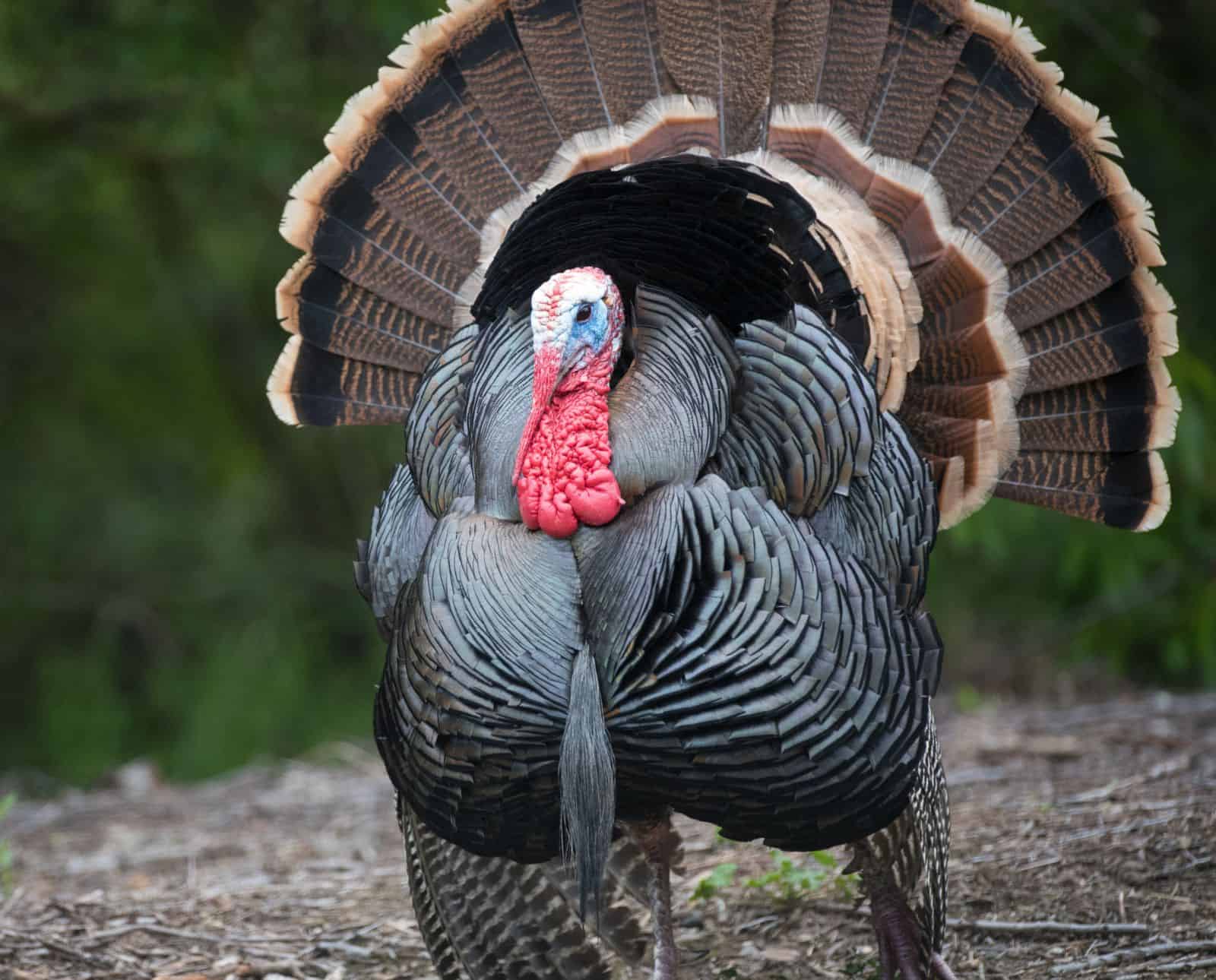
Gabby Zaldumbide is Project Upland's Editor in Chief. Gabby was…
Learn about wild turkey habitat, behavior, and hunting strategies before embarking on a hunt.
Wild turkeys are tough birds. You might hear hunters call them everything from bird-brained to a string of expletives. Yet, despite being almost driven to extinction in the early 1900s, wild turkeys are extremely good at what they evolved to do: survive. Their impressive ability to avoid predation is what frustrates so many turkey hunters year after year.
Filling a turkey tag doesn’t come easy, especially when you’re unprepared. Thankfully, there are a few simple things you can do to increase your chances of success. They include understanding your local turkey species, identifying turkey habitat, and being familiar with a few tried-and-true hunting tactics.
Learn Your Local Turkey Species
There are five subspecies of wild turkeys in the United States: Eastern, Merriam’s, Rio Grande, Osceola (Florida), and Gould’s. Here’s a quick breakdown of their ranges:
| Wild Turkey Subspecies | Range in the United States |
| Eastern Wild Turkey | East of the Mississippi River |
| Rio Grande Wild Turkey | Grasslands and river bottoms of the central prairie and Rocky Mountain states |
| Merriam’s Wild Turkey | Rocky Mountains |
| Osceola or Florida Wild Turkey | Florida |
| Gould’s Wild Turkey | Arizona and New Mexico |
Each subspecies of wild turkey has its own habitat preferences and quirks. Do some research and call your local state fish and game office to get intel about your regional subspecies. If you’re planning on turkey hunting in a different state, call the office closest to the area you’ll be hunting in. They’ll likely share some priceless information about what foods the local birds prefer, insights into their daily movements, and where you may find birds.
Identify Turkey Habitat
Turkey habitat contains the three things turkeys need to survive: food, water, and shelter. Finding a hunting spot with all three will reap rewards for savvy turkey hunters.
First, hone in on what foods your local turkeys favor. Wild turkeys are omnivores and will capitalize on any abundant food source during the breeding season. Do crop fields dominate your hunting area? Do you know of a hidden meadow in the dense woods bursting with new growth and insects? Checking calorie-dense locations close to water sources for turkey sign is a great place to start.
Again, I always recommend calling your state game agency to learn more about what foods your local birds target. They’ll have valuable insights about which plants, bugs, or tree mast wild turkeys are clued into.
Turkey shelter can look like a lot of things. In the evening, it can look like a roost tree. During the day, shelter can be a huge field where a flock of turkeys has a 360-degree view. Areas where turkeys can loaf around while feeling safe that are also within close proximity to primary food and water sources can be a great spot to target come turkey season. Additionally, the corridors birds use to travel from roosting to feeding areas are great places to hunt as well.
Understanding Turkey Behavior
Turkeys breed and nest in the springtime. Gobbling and strutting are how male wild turkeys attract mates. Most commonly, males display in open areas, and females travel to them. Hunters usually attempt to reverse this natural behavior. Hunters remain in one place, oftentimes using hen calls and hen decoys, to bring in a male turkey. Sometimes, this technique works flawlessly. Other times, toms can get “hung up” out of shooting range, likely because they’re expecting the female turkey to approach them.
Turkey sounds can help humans understand turkey behavior. A calm, feeding hen that wanders into your decoys will be a much better “live decoy” than an alert hen emitting warning calls.
Turkey Sounds
Wild turkeys make a variety of sounds, but hunters typically hear six of them. onX and the National Wild Turkey Federation provide examples of these sounds in Turkey Call History and Calling Tips:
- Gobble: Male turkeys gobble to attract females and communicate with other males. They will also gobble if they are surprised, which is called a shock gobble.
- Spit and drum: Another sound made by displaying toms, the male turkeys will make a spitting noise followed by a gutteral drum. Hunters need to be very close to displaying males to hear this sound.
- Putt: A single putt acts as an alarm call, communicating to other turkeys that danger is nearby. Hearing a series of putts from your hunting blind likely means your cover is blown.
- Purr: Purrs are commonly heard by feeding wild turkeys that feel safe.
- Yelp: Yelps are the most common wild turkey call. Hens use them to locate other birds and encourage other birds to join her.
- Cut: Usually fired off in a rapid series, cuts usually indicate that a hen is excited and wants to get a male turkey’s attention. They can also be emitted from an angry hen.
Clucks, yelps, and purrs can all vary in volume and intensity. Soft, quiet turkey sounds generally symbolize contentment. Loud, frantic-sounding calls emit a sense of urgency, which can tell other turkeys that danger is afoot.
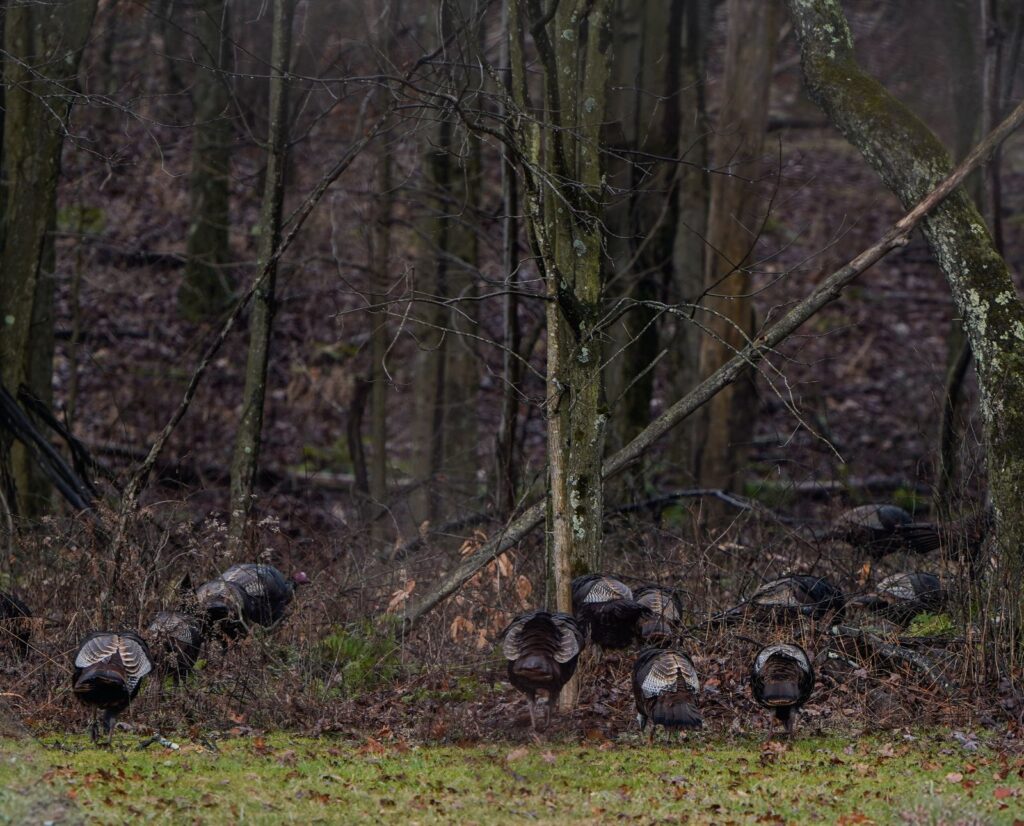
Wild Turkey Daily Habits
In general, turkeys live in flocks. Flocks roost at night, fly down each morning, feed and loaf during the day, then fly back up into a roost each evening. Since their daily habits are so cyclical, they can be relatively easy to pattern.
Wild turkeys can travel anywhere from one to five miles in a day. While this isn’t a huge distance, it’s far enough that they likely won’t use exactly the same fields or roost trees every day. However, they will still be in the same general area.
If you locate a flock of turkeys prior to spring turkey season, spend some time patterning their movements. After dinner, consider driving around with some binoculars to locate their roost tree that evening. Before long, you might find their four favorite trees and their preferred ways of entering each roost. That’s important information for a turkey hunter looking to fill their tag.
Turkey Hunting Gear
The gear you use to hunt turkeys should fit your preferred hunting strategies, local environment, and outdoor needs.
Clothing
Arguably, camouflage is necessary for hunting turkeys. Like all birds, wild turkeys have incredible vision. Not only are they excellent at detecting small movements, they see in color. In fact, birds actually see more colors than humans do. This means that blending into the environment is critical.
Additionally, blaze orange is exceptionally bright to birds, including small logos or decals on otherwise camo or earth-toned clothing. Make sure your turkey hunting clothes have no bright marks or features on them. If they do, don’t even twitch when they come within shooting range.
Vests And Backpacks
Many hunters utilize a turkey hunting vest. Like a fly fishing vest, they have many pockets on the outside for holding calls, shells, and snacks, and some even have a built-in cushion you can sit on while you wait for birds to come in.
If you’re hunting less than a mile from the truck or house, turkey vests are awesome. However, if you plan to hike several miles or stay out all day, consider wearing a backpack. For example, I live in western Colorado, which is Merriam’s country. Here, turkey hunting is more like elk hunting. When hunting Merriam’s, a backpack allows me to “run and gun” with my turkey decoys, water, a meal or two, emergency supplies, extra layers, and field dressing equipment.
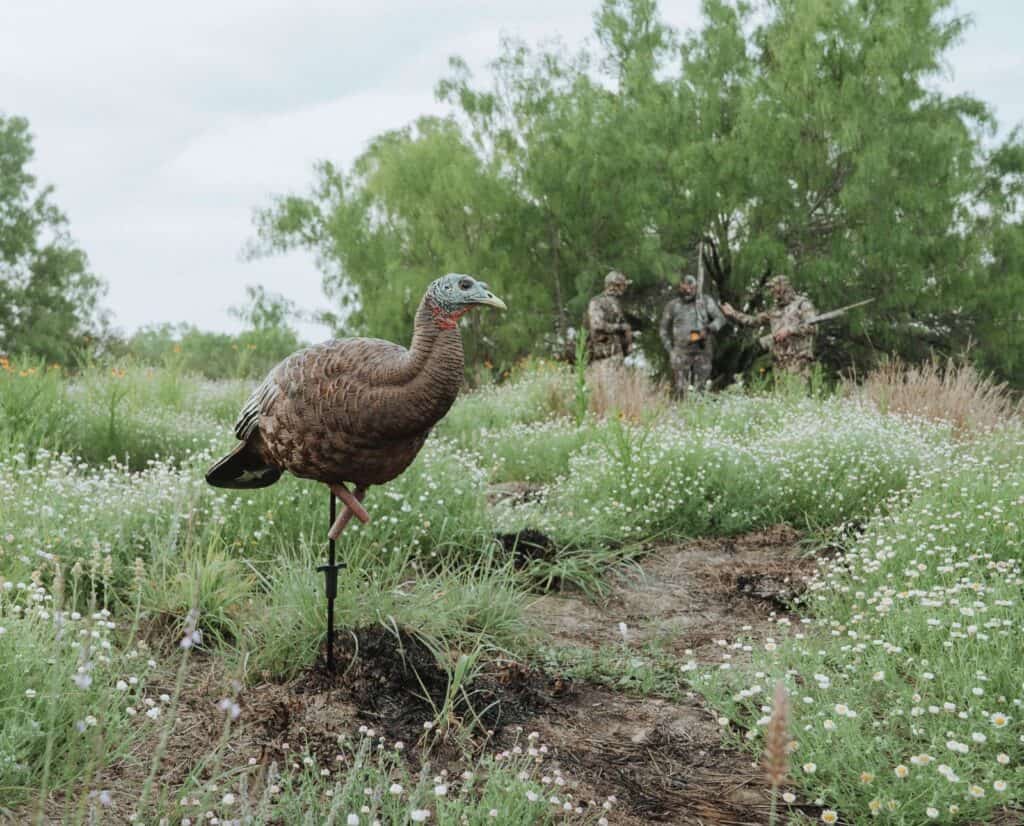
Decoys
The one piece of gear that can make or break a turkey hunt is a turkey decoy. Usually made out of hard plastic, foam, or a compressible material, turkey decoys trick real turkeys. Manufacturers make mature male, female, and immature male turkey decoys. Planning your decoy spread in advance can help you be successful.
To effectively use decoys, consider wild turkey behavior. For example, a lone hen decoy nestled in the grass sends a different message than a standing hen decoy with a jake, or immature male, decoy placed right next to it. An aroused mature male turkey, or tom, will be excited to find a lone hen. However, a tom may feel angered by a jake claiming a hen. The tom may become aggressive and attack the jake decoy.
I have never heard of someone using a spread of all mature toms, but I’m sure someone out there does.
Firearms
When it comes to methods of take, most turkey hunters wield a 12 gauge shotgun. Many others hunt turkeys with a 20 gauge. Some hunters bowhunt turkeys. Very few states allow turkeys to be taken with a rimfire rifle in the spring. In general, always check your state’s turkey hunting regulations before going into the field. Wield a firearm you’re comfortable using to hunt turkeys.
Pattern Your Shotgun
Much like how big game hunters sight in their rifles, it’s important for turkey hunters to pattern their shotguns. Patterning your shotgun is simple and straightforward. By doing so, you’ll understand how your turkey load spreads patterns at different distances.
If you’re an upland or waterfowl hunter, you are likely already familiar with your favorite load’s spread at different distances. Turkey loads vary between shot size, shot material, and shell length, making it extra important to test your shells at the range prior to hunting. Plus, things get more complicated if you use a choke.
How To Pattern A Shotgun
To pattern your shotgun, first, set up turkey-shaped paper targets at staggered distances, preferably 15, 25, 35, 45, and 55 yards away. Write each distance onto the target so you don’t accidentally mix them up later. Understanding your load’s performance at these distances will give you a very good understanding of your shotgun’s pattern. At a minimum, set up three targets: one at 10, 25, and 40 yards.
Next, shoot each target exactly as you would if you were in the field. Raise your gun to your shoulder, aim at the base of the turkey’s neck, and pull the trigger. When you’re done shooting, collect each target. Lay them out and observe how tight your gun’s spread was at 15 yards and how open it was at 55. Count how many pellets struck the image of the turkey on each target, and write that number down, too. Take a minute to compare how many pellets hit the bird at 25 yards versus 55 yards.
What did you learn? Perhaps you’re a terrible close-range shot, and your 15-yard hit nearly missed the bird, but the 25-yard turkey target had 23 hits to the neck and head. Take this valuable intel into the field with you.
Repeat this process with other chokes and turkey loads to learn which setup you shoot best.
A good rule of thumb is that an effective, well-placed shot equals at least 15 pellets to the head and neck area of a turkey target. Pack your rangefinder on your upcoming turkey hunt and have a solid understanding of your shotgun’s performance.
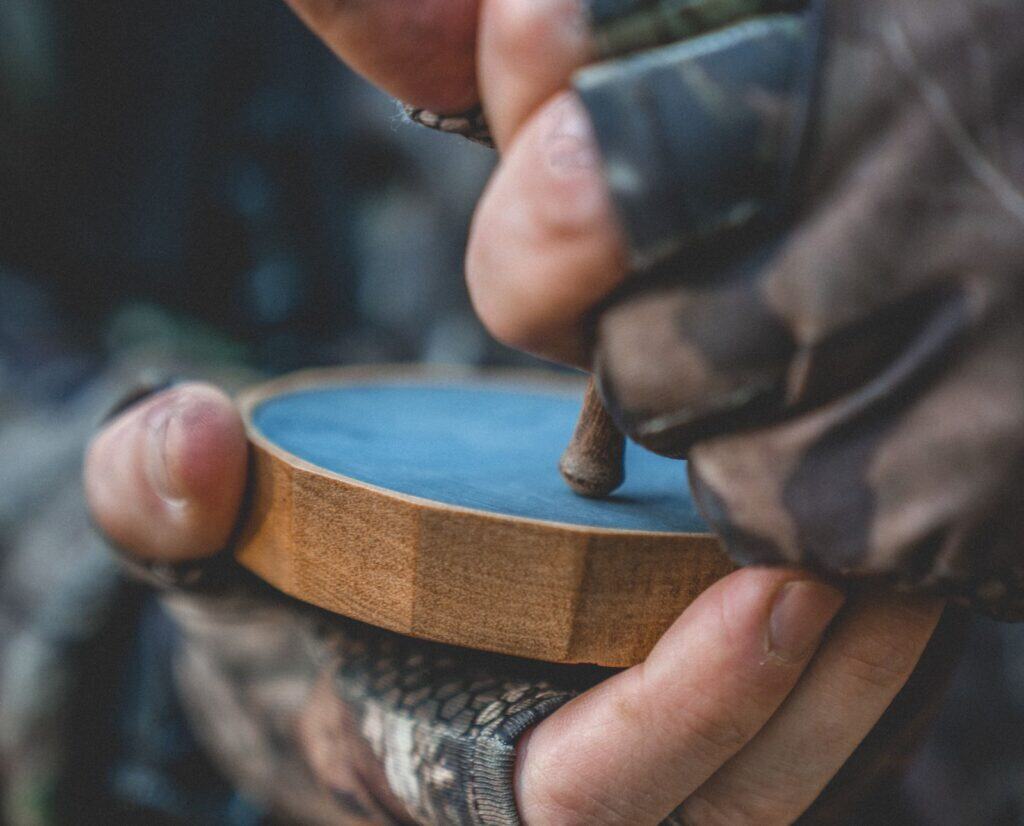
Using Turkey Calls
There are six general types of calls turkey hunters use:
- Box calls
- Slate calls or pot calls
- Push-button calls
- Diaphragm calls, also known as mouth calls
- Locator calls include non-turkey sounds imitating crows, owls, and coyotes
- Wing bone calls are typically handmade and uncommon
Friction Calls
Box calls are the most popular type of turkey call. They are friction-based and can recreate every sound a wild turkey makes from gobbling to putting to purring. They’re widely available, affordable, and beginner friendly.
One drawback to box calls is that in high pressure areas, turkeys grow accustomed to a box call’s specific sound, volume, and pitch. They know it’s not a wild bird. Another one is that box calls tend to be very loud. Their volume makes it difficult to recreate calm, quiet turkey sounds. Note that you’ll have to keep your box call from making noise if it’s in your pack or pocket. I keep mine shut with a rubber band (which also allows me to make loud gobbling sounds).
Slate calls, or pot calls, are also friction calls. However, they feature a smooth slab of slate that a hunter rubs with a wooden striker to create a squeaky, turkey-like sound. Great slate callers can make every turkey sound known to man with one of these. Like box calls, they are also easy to find in stores and are popular. They also can’t squeak in your backpack.
The third type of friction call is a push-button call. They’re very similar to a box call, but use a little wooden button to scrape chalked wood together instead of a sweeping hand movement. They tend to be quieter and less versatile than a box call, but they require less movement to use. I find that they’re exceptionally good at recreating purring sounds.
Diaphragm Calls
Diaphragm or mouth calls are the lightest turkey call on the market. They are also widely available, affordable, and popular. Mouth calls are made of a thin slice of rubber stretched over a horseshoe-shaped piece of soft plastic. Diaphragms snug up against the roof of the caller’s mouth, and the caller uses air and tongue movements to create vibrant turkey sounds.
It takes a minute to get good at using a mouth call. Be sure to practice with it at home before you use it in your hunting spot.
Locator Calls
Locator calls aren’t used to make turkey sounds. Instead, they’re meant to induce a shock gobble, or an eruption of gobbles as a result of being surprised, in male turkeys. Usually, they are reed-based mouth calls that imitate crows, owls, or coyotes. Locator calls tend to be used the most by hunters attempting to roost turkeys or spot-and-stalk birds.
Roosting Turkeys
Roosting turkeys refers to locating a tree or other roosting area that turkeys use as a safe place to sleep. Wild turkeys go to roost every evening and fly down every morning. Wild birds only like specific types of roosts. Typically, they are old, large-limbed trees capable of holding a flock of 20-pound birds.
Hunters “roosting turkeys” are scouting their hunting area in search of the trees wild turkeys are using. If you hear someone say “they put the turkeys to bed,” they watched a flock of turkeys fly into a tree. Those birds will still be there in the morning, so setting up near the roosting tree is a great way to increase the odds of connecting on a bird.
Turkeys habitually use a handful of roosts in one area. They won’t always be in the exact same roost, but it’s likely they’ll stay in that general area. Keep an eye on the flock to learn which trees they use and when, and plan your hunt accordingly.
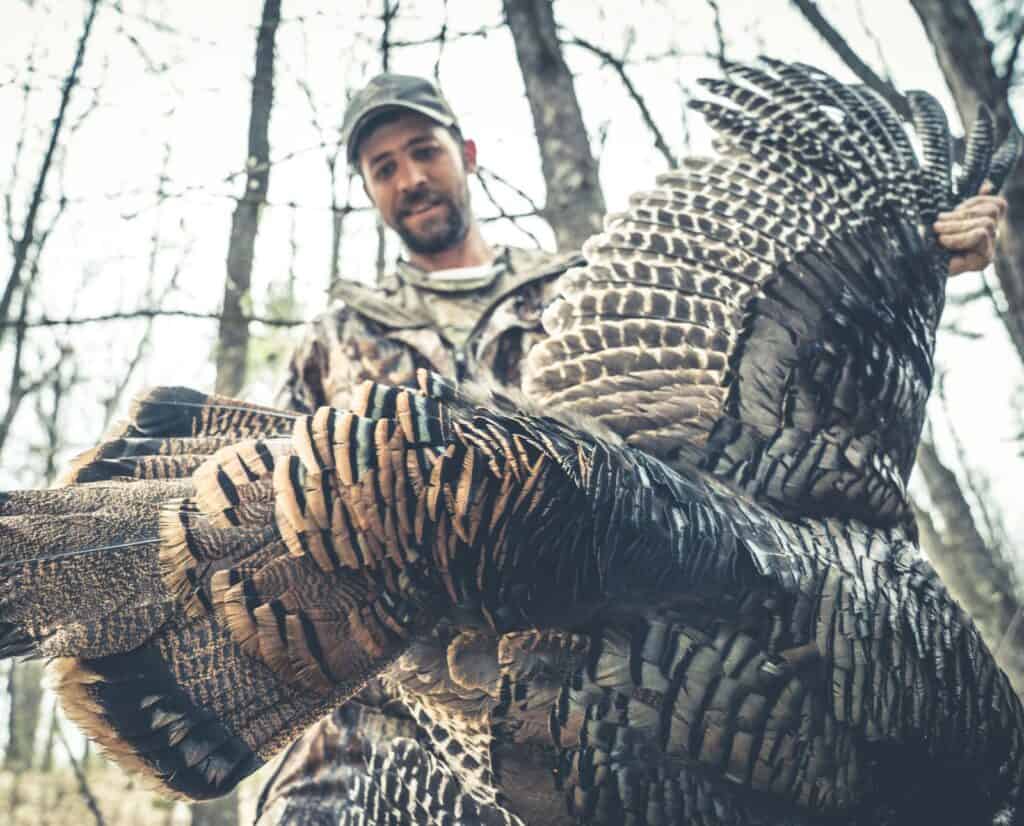
Classic Wild Turkey Hunting Strategies
Regardless of where you’re hunting, there are two universal turkey hunting strategies hunters use: ambush hunting and spot-and-stalk hunting.
No matter which turkey hunting style you use, aim at the lower portion of a turkey’s neck, right above the breast, when shooting at one. The head is a very small, fast-moving target. You optimize your shotgun’s spread when aiming at the largest and most lethal target available to you. Ideally, your bird will die quickly and no meat will be harmed with an on-target hit to the lower neck.
Ambush Hunting
Ambush hunting is by far the most popular type of turkey hunting. When using this method, hunters set up a ground blind, set turkey decoys in a realistic spread in front of it, and use turkey calls to convince toms to walk into shooting range. Ambush hunting is a great way to hunt birds you know roost in a specific area or habitually use the same feeding area every day.
Spot-And-Stalk
Spot-and-stalk turkey hunting is exactly what it sounds like: you spot a wild turkey (or hear one gobbling in the distance), and you creep up on it. Sometimes, you can sneak up within shooting distance of a completely distracted, strutting bird. More often, you’ll be able to stalk within 100 yards, then use turkey calls and decoys to get the bird to close the final distance. Doing so decreases the chance that the bird will see you before you get a shot opportunity.
Keep in mind that spot-and-stalk hunting is most commonly used in the West. In fact, it’s frowned upon to stalk turkeys out east or in areas where other hunters may be present. Stalking birds that turn out to be another hunter using turkey calls can be unsafe for everyone involved.
Wild Turkey Conservation Groups
The National Wild Turkey Federation (NWTF)
Turkeys for Tomorrow (TFT)
Michigan Wild Turkey Hunters Association (MWTHA)
Gabby Zaldumbide is Project Upland's Editor in Chief. Gabby was born in Maryland and raised in southern Wisconsin, where she also studied wildlife ecology at the University of Wisconsin-Madison. In 2018, she moved to Gunnison, Colorado to earn her master's in public land management from Western Colorado University. Gabby still lives there today and shares 11 acres with eight dogs, five horses, and three cats. She herds cows for a local rancher on the side.





